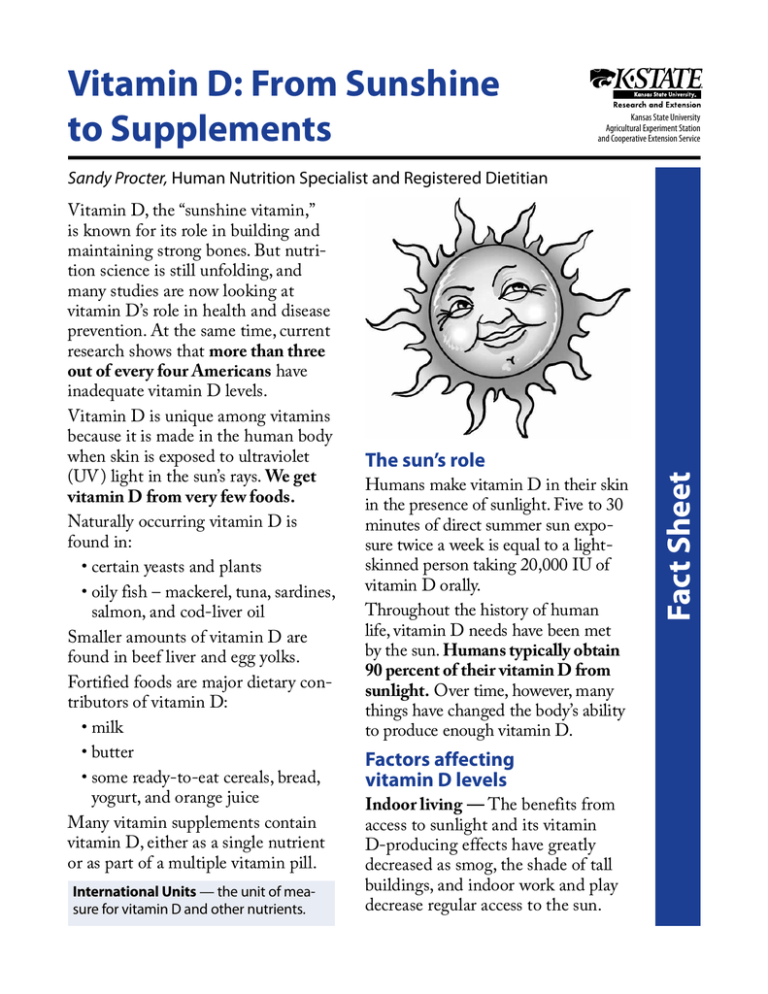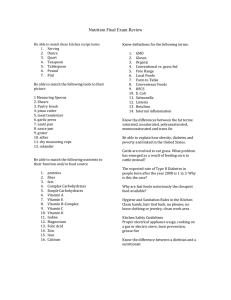
Vitamin D: From Sunshine
to Supplements
Kansas State University
Agricultural Experiment Station
and Cooperative Extension Service
Vitamin D, the “sunshine vitamin,”
is known for its role in building and
maintaining strong bones. But nutrition science is still unfolding, and
many studies are now looking at
vitamin D’s role in health and disease
prevention. At the same time, current
research shows that more than three
out of every four Americans have
inadequate vitamin D levels.
Vitamin D is unique among vitamins
because it is made in the human body
when skin is exposed to ultraviolet
(UV) light in the sun’s rays. We get
vitamin D from very few foods.
Naturally occurring vitamin D is
found in:
•certain yeasts and plants
•oily fish – mackerel, tuna, sardines,
salmon, and cod-liver oil
Smaller amounts of vitamin D are
found in beef liver and egg yolks.
Fortified foods are major dietary contributors of vitamin D:
•milk
•butter
•some ready-to-eat cereals, bread,
yogurt, and orange juice
Many vitamin supplements contain
vitamin D, either as a single nutrient
or as part of a multiple vitamin pill.
International Units — the unit of measure for vitamin D and other nutrients.
The sun’s role
Humans make vitamin D in their skin
in the presence of sunlight. Five to 30
minutes of direct summer sun exposure twice a week is equal to a lightskinned person taking 20,000 IU of
vitamin D orally.
Throughout the history of human
life, vitamin D needs have been met
by the sun. Humans typically obtain
90 percent of their vitamin D from
sunlight. Over time, however, many
things have changed the body’s ability
to produce enough vitamin D.
Factors affecting
vitamin D levels
Indoor living — The benefits from
access to sunlight and its vitamin
D-producing effects have greatly
decreased as smog, the shade of tall
buildings, and indoor work and play
decrease regular access to the sun.
Fact Sheet
Sandy Procter, Human Nutrition Specialist and Registered Dietitian
2
Sunscreen — Wearing sunscreen to
protect from overexposure to the sun’s
harmful rays is an important health
precaution. However, sunscreen
blocks the body’s ability to make
vitamin D.
Season and latitude — Winter sunlight (from December to February in
Kansas) is too indirect for vitamin D
formation in most of the middle and
northern United States. UV exposure is strongest in areas at or near
the equator. Stored levels of vitamin
D drop during winter months, and
experts believe immunity drops as a
result. This could explain why winter
is “cold and flu” season.
Overweight/obesity — Body fat
interferes with how vitamin D is
formed and stored in the body. Persons who are obese (BMI of 30 or
greater) are more likely to be deficient of vitamin D than persons with
a lower BMI, because the vitamin is
“trapped” in fat stores and unavailable
for the body’s use.
Age — As people age (50 and older),
they are less able to produce vitamin
D due to lower levels of pre-vitamin
D in the skin.
Skin color — Persons with dark
skin produce vitamin D at a lower
rate than persons with lighter skin
because of more pigment, melanin, in
dark skin. Research is examining if
this could explain why certain illnesses, such as high blood pressure or
end-stage renal disease, strike nonHispanic black persons more frequently than other racial groups.
Breastfeeding — Infant vitamin D
requirements cannot typically be met
Oily fish, such as salmon, is a source of vitamin D.
by human milk alone. Breast milk
varies in the amount of vitamin D it
contains, but experts believe this is
due to low levels of vitamin D in the
mother, which lead to low levels of
vitamin D in her breast milk.
A recent increase in nutritional rickets, especially in African American
infants and children, led the American Academy of Pediatrics to recommend 400 IU of vitamin D each day,
beginning at birth to age 1. This
doubling of previous recommended
intake levels for infants was implemented to combat rickets – the classic vitamin D deficiency disease.
Why the interest in vitamin D?
In addition to its vital role in bone
health, vitamin D continues to be
studied for a wide variety of possible
health benefits. As a hormone, vitamin D binds to receptor cells in the
body, which in turn have the ability to control a far-reaching range
of hormone and gene-expressing
processes. These processes influence
a vast number of the body’s health
responses. Here are some current
areas of vitamin D research:
Vitamin D and immunity — Vitamin
D plays an important role in keeping
the body’s immune system healthy.
If the body is low on vitamin D, scientists believe it is less able to fight
off infections and diseases. Adequate
vitamin D is needed to prevent autoimmunity — The abnormal response
of the immune system that causes the
body to attack its own cells and tissues.
Research focuses on the role of vitamin D deficiency in several autoimmune diseases, including rheumatoid
arthritis and multiple sclerosis.
Vitamin D and cancer — Vitamin D
regulates a number of genes in several
cancers, including prostate, colon, and
breast cancers. Other studies appear to
suggest that low levels of the vitamin
may not only affect the outcome of a
cancer diagnosis, but may even play a
role in the cause of certain cancers.
Vitamin D and diabetes — Adequate
vitamin D appears to play an important role in improving the body’s sensitivity to insulin, thereby lowering the
risk of diabetes. Not only may vitamin
D prevent or delay the onset of diabetes, recent research also shows that
vitamin D may reduce complications
for those already diagnosed.
How much vitamin D
do people need?
Vitamin D is required throughout life,
from before birth through old age.
New daily recommendations are:
•Infants to age 1:
400 IU
•Children 1 to 18 years: 600 IU
•Adults age 19 to 70: 600 IU
•Adults age 71+:
800 IU
Tolerable upper levels of intake —
The upper levels of vitamin D are
at the high end of the safety scale
and should not be misunderstood as
amounts people need or should try to
consume. The Institute of Medicine
encourages adults to stay below 4000
IU per day, from both food and supplements, to avoid the risk of harm.
Self-help steps
to boost vitamin D levels
What can you do to protect your
health and avoid vitamin D deficiency?
Some tips for self care.
Talk to your doc. Many health-care
providers recommend a simple lab
test to determine vitamin D level.
Your doctor can determine if vitamin
D supplements are right for you.
Let the sun shine! While moderate exposure to sun is an ideal way to
increase vitamin D levels for many
people, too much unprotected sun
exposure is known to lead to skin
cancer. Experts in vitamin D research
believe five to 30 minutes, twice a
week, of direct sun on exposed skin
without sunscreen allows lightskinned persons to manufacture
ample vitamin D. Persons with dark
skin may require up to three times as
much sun exposure. Ask your healthcare provider how much sunlight
exposure is right for you.
Focus on food. The foods listed
on page 1 are natural and fortified
sources of vitamin D. Read the Nutrition Facts label. If vitamin D is added
to a food, you will see it on the label.
Mind your meds. Several medications have the potential to increase the
3
destruction of vitamin D in the body.
These include corticosteroids such as
prednisone, which impairs vitamin
D metabolism. The weight-loss drug
orlistat (brand names Xenical and
alli) , and the cholesterol-lowering
drug cholestyramine (brand names
Questran, LoCholest, and Prevalite) can
reduce vitamin D absorption. Individuals taking these medications should
discuss vitamin D levels and intake
with their health-care provider.
Research will be ongoing to determine the optimal amount of vitamin
D needed. Vitamin D will remain in
the news. The Institute of Medicine
committee assessing Dietary Reference Intakes (DRIs) released results
of their report on vitamin D recommendations in November 2010.
Author
Sandy Procter, Ph.D., RD, LD
204 Justin Hall
Manhattan, KS 66506
procter@ksu.edu
Acknowledgements
Special thanks to Denis Medeiros,
Ph.D., RD, and Lisa J. Martin, MPH,
RD, for reviewing this lesson.
References and Resources
Office of Dietary Supplements. National Institutes
of Health. Dietary supplement fact sheet: Vitamin D.
Updated 12/11/08. Retrieved October 15, 2009, from
http://ods.od.nih.gov/factsheets/VitaminD_pf.asp
Wagner C.L., Taylor S.N., Hollis, B.W. (2008). “Does
vitamin D make the world go ‘round’?” Breastfeeding
Medicine 3 (4), 239-250.
Wagner C.L., Greer, F.R., Section on Breastfeeding
and Committee on Nutrition (2008). “Prevention of
rickets and vitamin D deficiency in infants, children,
and adolescents.” Pediatrics 122(5), 1142-1152.
Linus Pauling Institute, Micronutrient Research for
Optimum Health. (2008, January). “Vitamin D.”
Retrieved Nov, 17, 2009, from http://lpi.oregonstate.edu/
infocenter/vitamins/vitaminD
University of California-Riverside (1999). History of
vitamin D. Retrieved October 13, 2009, from http://
vitamind.ucr.edu/history.html
Vitamin D Council. Understanding vitamin D cholecalciferol. Retrieved January 13, 2010, from http://www.
vitamindcouncil.org
Institute of Medicine of the National Academies
(2010). Report brief. Dietary reference intakes for calcium
and vitamin D. Retrieved November 30, 2010, from
http://www.iom.edu
Brand names appearing in this publication are for product identification purposes only. No endorsement is intended, nor is criticism implied of similar products not mentioned.
Publications from Kansas State University are available on the World Wide Web at: www.ksre.ksu.edu
Publications are reviewed or revised annually by appropriate faculty to reflect current research and practice. Date shown is that of publication or last revision.
Contents of this publication may be freely reproduced for educational purposes. All other rights reserved.
In each case, credit Sandy Procter, Vitamin D: From Sunshine to Supplements, Fact Sheet, Kansas State University, December 2010.
4
Kansas State University Agricultural Experiment Station and Cooperative Extension Service
MF2927 (Rev.)
December 2010
K-State Research and Extension is an equal opportunity provider and employer. Issued in furtherance of Cooperative Extension Work, Acts of May 8 and June 30, 1914, as amended.
Kansas State University, County Extension Councils, Extension Districts, and United States Department of Agriculture Cooperating, Gary Pierzynski, Interim Director.









